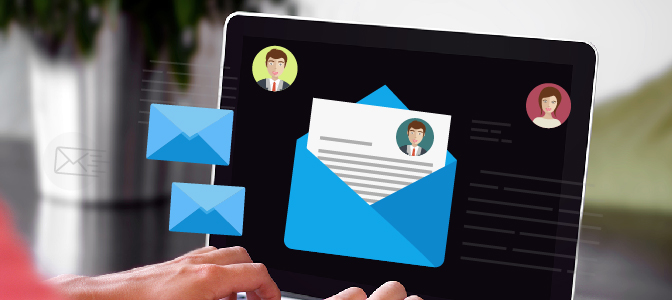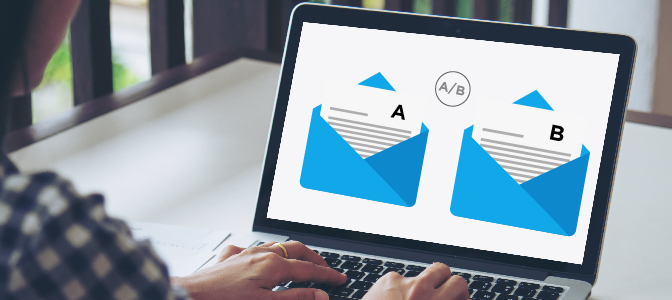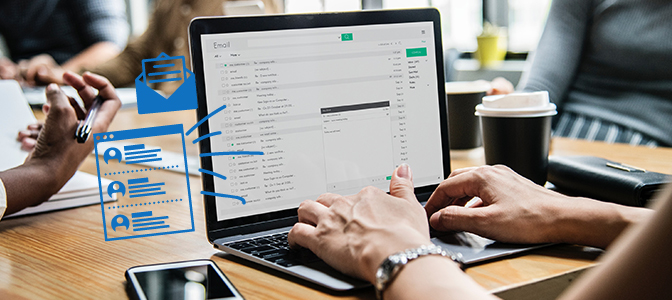11 best practices for effective email subject lines
The importance of email subject lines is often overlooked. You can draft a killer sales or marketing email, but if the subject line doesn’t grab the recipient’s attention, your email will never be read. And grabbing recipients’ attention is not the only variable at work. Some other commonly used tactics can result in your email never arriving or being sent directly to spam folders.
The goal of drafting the perfect email subject line is a moving target. What worked a few years ago likely doesn’t work today. You must constantly stay up-to-date on spam triggers and remain in touch with consumers’ behaviors, needs, and interests.
There are many opinions on what it takes to reach greatness with your email subject lines. Part of the equation revolves around knowing and engaging your unique audience. Another part hinges on effectively navigating the technical element of email subject lines for sales and marketing.
Here, we’ve compiled the 11 most important best practices for email subject lines. Follow these tips, and you’ll be on your way to generating more opens and click-throughs and driving up engagement with your emails.
1. Get personal

Personalization is a hot topic email marketing trend. The days are long gone when personalization simply entailed including the recipient’s name in the subject line. With the advance of machine learning and artificial intelligence, marketers can personalize to a high-degree. They can leverage so much more data and use it in more dynamic ways than ever before.
An email that arrives and references your customers’ or prospects’ industry, geographical location, past buying behavior, likes, interests, etc. in the subject line is far more likely to result in an open. With the use of marketing automation, this is easier than ever. The more relevant and personal your email subject lines are, the higher your open and response rate will be.
2. Segment your audience for a highly relevant message
Do you typically send the same email to all your prospects or customers in a generic blast? If so, stop.
Unless your target audience is demographically static and uniform, you should always segment your audience and tailor your email subject lines to each segment.
Your audience is comprised of humans, and it’s important to speak directly to them. When used alongside personalization, segmentation allows you to draft email subject lines that are even more relevant to the recipient.
Example: Let’s say you sell an array of career services to customers in varying locations and industries. One customer is a recent graduate in Massachusetts looking for a job in engineering. Another customer is an executive with years of experience in the hospitality industry searching for a job in Kentucky. You could send an email to them both with a subject line that reads:
“New services available in your area.”
Or—with the use of personalization and segmentation—you could send two different targeted emails that speak to each of your respective customers. Those could read:
1) “Check out new engineering opportunities in MA”
2) “Seeking hospitality executives in KY”
It doesn’t take a genius to see which tactic would be more effective.
Related Blog: 5 Tips for Advanced Email Personalization
3. Be concise and clear about what your email delivers.

What is your email about? What are you offering? Are you notifying recipients about a new product launch, an event, a special discount offers or coupons? Your email subject lines will obviously vary in every situation. The key is to make it very clear what the email contains and leave no doubt what readers will find inside when they open it.
Example: Imagine that you are offering a killer new eBook about the future of the SaaS industry as part of your content marketing efforts. You should say so clearly in your subject line. Don’t dance around the point, get right to it.
Avoid trying to be overly creative and clever with a subject line like this:
“Want to be part of the future?”
Instead, be very clear that you’re offering an eBook on the SaaS industry, with a subject line such as:
“[eBook] The future of the SaaS industry”
4. Don’t over-promise or mislead
If you promise the moon but don’t deliver, you’ll see your unsubscribe rate climb. If your email subject lines are misleading, people will quickly realize.
False assumption: If you send an email with a subject line that embellishes a little, it will increase your open rate, and people are likely to click-through once they open the email simply because they opened it.
Reality: If they open your email and it doesn’t contain what you communicated in your subject line, they are likely to unsubscribe. It may temporarily boost your open rate, but that rate will drop as fast as it rose once people catch on. It’s simply not worth it, so be honest with your audience.
5. A/B test different email subject lines

A/B testing allows you to try out two different email subject lines for the same email. Your marketing automation solution should provide A/B testing capabilities.
Tip: If it doesn’t, you should look for a different marketing automation solution.
With two different email subject lines loaded into your email marketing platform, the system will send that email to two small sample groups within the larger targeted send group. Then, it will wait a specified amount of time to evaluate which subject line is generating more opens. The one that is performing better will then be sent to the rest of the group.
A/B testing in this way allows you to experiment with different tactics and hone in on the approach that engages your audience the most.
6. Avoid spam trigger words
69% of emails that are flagged as spam are flagged as such because of the email subject line.
Lots of research has been done to identify the words that throw up red flags on spam detectors. Using certain words in your email subject lines can result in your email being automatically blocked or sent directly to your recipients’ spam folders.
Here is the list of the most common spam trigger words that are flagged by spam detectors. Browse it at your leisure and educate yourself on which words to stay away from in your email subject lines.
7. Use numbers

Email subject lines that contain numbers have been proven to generate higher open rates than those that do not.
Why?
Subject lines that include numbers—if you back that number up in your email body—convey a sense of credibility. Often, hard numbers can catch someone’s attention while a general description of something can easily be ignored.
8. Avoid emojis
I know, you’ve probably heard from a variety of sources that including emojis in your subject lines is a great way to make them stand out. And that can be true in some situations, but it’s not an objective fact that applies to all email subject lines for sales and marketing.
False assumption: Using emojis in your email subject lines will help grab the reader’s attention because they stand out from the rest of the subject lines in their inbox.
Reality: Emojis carry heavy cultural significance. Take a hand making an “OK” circle with the thumb and index finger. In some cultures, it means something positive, like an affirmative “OK.” In others, it can mean something vulgar and offensive. If your audience is in any way multicultural or international, you should refrain from using emojis. They could inadvertently alienate you from certain recipients and have the potential to hurt you more than they help you.
9. Communicate urgency

I don’t mean to imply that you should use the word “urgent” in your email subject lines. Nor that you should go over the top and make your subject lines sound dire or overly time sensitive.
However, you can use action-oriented language to convey a sense of urgency, while maintaining a legitimate tone of voice in your email subject lines.
Example: If you have a limited time offer, you want to communicate a sense of urgency around it so that people will act quickly.
Instead of using a soft subject line like this:
“We have a special offer”
Consider using action phrases that convey a sense of urgency and clearly state what the offer is about. Something like this will be much more effective:
“Don’t miss our limited time offer on [product name]”
10. Use questions to pique the interest
A great way to grab your audience’s attention is to pose a question that makes people realize they have a problem in need of solving. If you lead with a question that makes recipient’s think, you’re on the right path. You can pull on emotional strings with a simple question if it’s worded correctly.
Example: Let’s say you sell project management software that helps streamline workflows and saves users time. If you convey to the recipient that they may be facilitating inefficiency by not using your product, you’re liable to grab their attention enough for them to open your email. To accomplish that, you could use a subject line such as this:
“Do you maximize efficiency like your competitors?”
Related Blog: 6 Easy Ways to Increase Email Open Rates Today
11. Use humor carefully

Trying to use humor in your email subject lines is about as tricky as using emojis. Humor is culturally relative. What is funny to one culture, may be offensive to another.
Plus, when you attempt to use humor, it begs the question: are you actually funny?
Funny email subject lines are harder to write than most think.
Is it even possible to write a subject line that is funny to your entire audience? Probably not.
I mentioned above that personalization and segmentation allow you to deliver a highly relevant message because emails that are not relevant to the recipient will be glossed over and forgotten. Humor is similar. It may be relevant to a few recipients and make them laugh, but it may be completely irrelevant to other recipients, doing more harm than good.
Unless you’re a comedian, leave the humor to the professionals.
Conclusion
Drafting the perfect subject line is an art. And in reality, there is no true “perfect email subject line.” What works for Company A is likely to produce negative results for Company B. And vice versa.
It’s critically important to know your audience and put yourself in their shoes when drafting your email subject lines. What will grab their attention? What is important and relevant to them?
The more you know your audience, the closer you will come to drafting the best email subject lines possible. Focus on that, avoid spam filters, use technology with artificial intelligence built in, and be honest with your audience. Doing so will allow you to differentiate yourself from your competition and will produce better email open rates as you strive for the elusive “perfect email subject line.”
2 Comments
Business Saathi Plus
about 6 years agoGreat Article!!! The importance of email subject lines is often neglected. Thanks for sharing this article.
ReplyGabriel Swain
about 6 years agoTotally! A great email is wasted if it has a poor subject line and no one opens it. It's crucial, but so many people overlook its importance. Sounds like you know your stuff! Thanks for the feedback!!
Reply